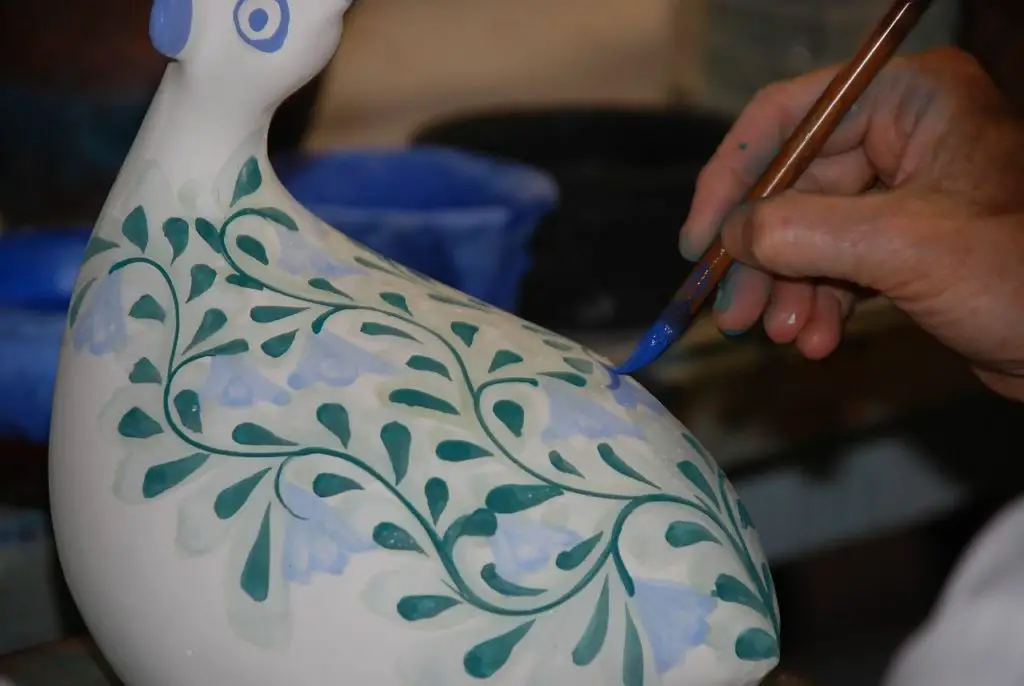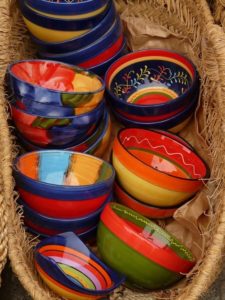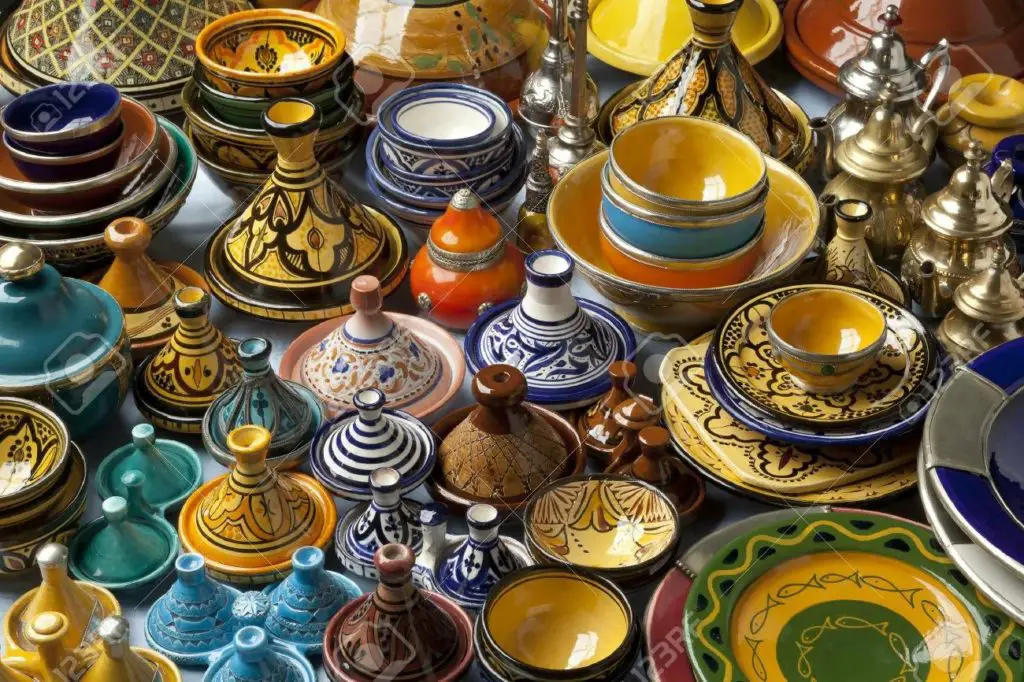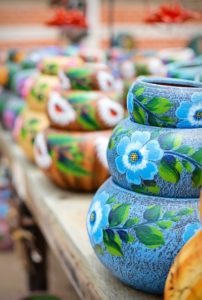I think the most beautiful thing to do for your pottery is to paint it. I have been asked a couple of times about how to paint pottery to make it look amazing. Some beginner potters find glazing too difficult and they are always asking for something easy to start with. We love taking the guesswork out and giving you easy tips and tricks to make just that happen. If you are in this category, you are in the right place. In this article, I will be revealing the industry’s secret on pottery painting for amazing looking pottery.

The ancient sources describe developments made in the art of pottery painting, and some can be traced to the ancient Athenian pottery. About 520 BC, it is said that the human figure was depicted as it had been in all earlier two-dimensional art, in profile, or, in a combination of profile and frontal views. Then, on some large well-made clay shapes, a few painters experimented towards the end of the 6th century with more realistic poses, attempting to show the human body as it was in life, not stylized as it had been in art. Around 400 BC potters evolved and started molding different pieces we have in existence today. Some of these masterpieces were painted and some were left unpainted. To date, pottery painting is still an important aspect of making amazing looking pottery today.
IMPORTANCE OF POTTERY PAINTING
Before we dive into the techniques and method of pottery painting, I want to talk about the need for pottery painting. Pottery Painting is easy but not that stress-free as you think it is; let’s take a moment to cherish the need for pottery painting.
1. Decoration
I don’t think I have to accentuate how beautiful and amazing pottery painting makes pottery look. Pottery Paint is silica-based glass constituents that create a smooth, fine glass surface over clay when it is melted at high or extremely cold temperatures. Oxides are used both under and over applications of clear glass paint for coloration and decoration. Today, different oxides are often mixed with other paint chemicals and available for potters at ceramic supply stores and online. These products are called underglazes (for application under a glassy look) or overglaze (applied on top of a glaze and refired.) Each one has a different decorative outcome. Summarily, gazes are used for decorative purposes. There are underglaze and overglaze when they mixed with water and painted on pottery with brushes to attain a pen-and-ink effect that resists firing at high temperatures.
2. Pottery painting is a way of communication
Art is a way of life and there is no use if your artwork cannot speak or pass on messages. A lot of potters tend to pass off information through their pottery pieces. The history and customs of Egyptians are usually encrypted on their pottery through their paints. A few artworks traced back to Egyptians can go as far as informing you about the lineage and family of potters that worked on the piece. Nowadays, a lot of mugs are being customized and designed with various
3. History
 Pottery painting has allowed historians and pottery specialists to be able to trace the history, customs, and cultures of different pottery pieces. According to the History World website, the Greeks started producing fired unpainted earthenware for storage and cooking purposes back in the 5th century BC. The pots were leaky and unable to hold water until the development of paints in the 1st century BC in Egypt. The first blue-green paint is commonly known as Egyptian paste and is still popular and being used around the world today. Painted ceramics were concurrently developed in early China and the Middle East, and traded along the famous Silk Road. Painted ceramics were popular commodities and the active exchange of ceramic styles and techniques impacted the future development of pottery. Early European pottery and painting techniques were influenced by eastern ceramics that traveled to Rome. A team of potters traced a piece in a museum back to the origin and the country it was fired 170 years after.
Pottery painting has allowed historians and pottery specialists to be able to trace the history, customs, and cultures of different pottery pieces. According to the History World website, the Greeks started producing fired unpainted earthenware for storage and cooking purposes back in the 5th century BC. The pots were leaky and unable to hold water until the development of paints in the 1st century BC in Egypt. The first blue-green paint is commonly known as Egyptian paste and is still popular and being used around the world today. Painted ceramics were concurrently developed in early China and the Middle East, and traded along the famous Silk Road. Painted ceramics were popular commodities and the active exchange of ceramic styles and techniques impacted the future development of pottery. Early European pottery and painting techniques were influenced by eastern ceramics that traveled to Rome. A team of potters traced a piece in a museum back to the origin and the country it was fired 170 years after.
4. Strengthens Clay
Pottery painting strengthens the entire clay body of any ceramic vessel. Potters often calculate paint ratio to the clay body, so the fired paint fits tightly on the ceramic surface, thereby compressing the clay molecules. Compression results in greater resistance to liquids and increased durability of the object. Painted objects tend to last for hundreds of years due to its rigidity. Unpainted objects are often broken easily due to their loose clay molecules.

5. Waterproofing
I think it is quite obvious that water is the poison of any form of pottery. But the antidote to this poison is pottery painting. Paint melts and flows evenly over an object when heated with temperatures between 1800 and 2400 degrees F–in a ceramics kiln. The paint melts and it coats the surfaces evenly with a thin coating of glass. As the glass cools slowly, the painted surface turns smooth and solid. The result is a tight surface that is water-resistant and holds liquids effectively over time. You must be careful when you are coordinating the expansion and shrinkage rates of paint over the clay body, or else you might experience cracking and crazing will occur during the heating and cooling process.
6. Painting stays longer on the body of the artwork
A ceramic paint coating goes much further than ordinary glazing which is used for protecting the surface of the piece. Traditional pottery glazes don’t last over time when they are being exposed to the weather, acidic components of the atmosphere, raindrops, etc, but the pottery painting lasts for years.
7. Cost-Effective:
Using ceramic paints on your pottery may take a huge amount of time of it can be costly but the long life of ceramic coating indirectly makes it highly cost-effective. Doing waxing or glazing will take time and waste of money if you have to do it very often, where you can have the same or even better feeling by using the ceramic paint once.
TECHNIQUES OF PAINTING YOUR POTTERY
| TECHNIQUES | POTTER RATING (OUT OF 10) |
| OXIDE STAIN | 6 out of 10 |
| ACRYLIC PAINT | 6 out of 10 |
| LACE | 4 out of 10 |
| SLIPS | 7 out of 10 |
| SILK SCREENS | 5 out of 10 |
| BUBBLES | 8 out of 10 |
| GLAZING | 9 out of 10 |
1) Oxide Stain
Oxide stains are brilliant for painting lines in a flow on your pottery piece, as well as adding broad areas of color to your piece. You can use commercially prepared stains, which often use fritted material to make them both chemically stable and safer in terms of food toxicity. Or, stains can simply be natural oxides mixed in water, but with these, you will need to handle on what glaze goes over it. Some oxides are unpredictable and will change color dramatically depending on what other constituents are in the glaze. For example, the popular chrome oxide is considered to be a green colorant, but if there is an element on the tin in the glaze constituents, it can go pink.
2) Acrylic Paint
 Acrylic Paint is often known as Nail paint/nail polish. As a beginner, it is more advisable to start your pottery painting skills with some nail polish. It works fine and it makes your pottery look amazing. Pottery artists can, and do, use any variety of other acrylic paints to decorate pottery pieces that do not need to be functional. But be aware that these pottery pieces are likely to shiver or peel off if the finished piece becomes wet or is intended for permanent outdoor use. Ceramic pieces designed to serve as display art is one area where artists frequently use acrylic paints.
Acrylic Paint is often known as Nail paint/nail polish. As a beginner, it is more advisable to start your pottery painting skills with some nail polish. It works fine and it makes your pottery look amazing. Pottery artists can, and do, use any variety of other acrylic paints to decorate pottery pieces that do not need to be functional. But be aware that these pottery pieces are likely to shiver or peel off if the finished piece becomes wet or is intended for permanent outdoor use. Ceramic pieces designed to serve as display art is one area where artists frequently use acrylic paints.
Two non-ceramic materials can be especially useful for this kind of painting. Acrylic paint is most commonly used, but fingernail polish can also create effective results. Unlike other paints, both these materials have the advantage of being non-water-soluble once they have dried.
Besides the lack of functionality, using acrylic paint or fingernail polish has another principle drawback: They can visually flatten and compromise the clay surface they cover. It can be quite hard to visually integrate these materials fully with the clay.
3) Lace
Lace is all about painting your pottery whatever color you like while it’s still wet, gently lay a piece of lace over the piece in whatever coverage and pattern you like. Then, paint over the lace! Softly peel the lace off the clay body and then voila, you’ve made yourself amazing looking pottery. Of course, there are some technicalities about it, but the more you practice, the more you get perfect at it.
4) Bubbles
This is my favorite technique of painting amazing looking pottery. It involves throwing some wet paint, water, and a little dish detergent in a cup and mix it up. Using a straw, blow onto your pottery piece like you did when you are trying to blow bubbles. Once the bubbles reach the top of your pottery piece, tilt your piece and allow the bubbles to fall off. The blown bubbles begin to settle on top of the pottery piece and then the bubbles leave a color stain behind. Do the same with other colors to give your project an impressive finishing.

5) Slip
A slip is a liquefied suspension of clay particles in water. It can also be used to color clay pottery before firing. To paint your pottery to make it amazing, you can either use white slips or colored slips tinted with oxides. Some potters save the slips that remain when molding other projects Slips are best used on wet pottery pieces.
Using slips as a technique of pottery painting makes it much easier to fully clean off mistakes. Slip painting better matches the clay’s shrinkage, which in turn means less worry about heavier applications cracking during drying or firing the piece. Because the slip painting gets bisque fired along with the piece, you can add additional color using underglazes (or other paintings) to decorate the pottery or to further define the image.
6) Silk Screens
These are extensions of a stencil. It takes the same approach as screen painting on a regular t-shirt. All you have to do is to mix regular paint of your choice with a powder solvent that thickens to the paint for application. (It’s kind of like adding flour to create a roux.) Then you will have to dunk your finger in the mixture and spread the thick mixture all across the surface of the silkscreen until the entire image is covered. Peel it  off, and you will have a perfect replica of the original image. We have an entire binder of silkscreen options available on a walk-in basis. We also have some that are reserved and only available for workshops and theme nights.
off, and you will have a perfect replica of the original image. We have an entire binder of silkscreen options available on a walk-in basis. We also have some that are reserved and only available for workshops and theme nights.
7) Glazing
I reserved this for the last. If you have gone through my previous blog posts, this won’t be a bloomer to you. Glazing your pottery piece is that finishing touch you add to your piece to make is distinct and unique from all other artists’ wares. The creative possibilities of glazing are infinite and the techniques and patterns you can create with them have no limit. Glazing can take an ordinary ceramic ware and make it an exquisite work of art. Glazing can turn ordinary to an astonishing work of art, but in the same vein, improper glazing techniques can ruin a pottery piece. That is why it is advisable to spend a bit of time planning and picturing the exact look, feel and color of what you want to achieve. Various glazes and clays have different properties, so you should put that into consideration before you begin the glazing process.
Whether your pottery project is a tiny mug or a large vase, painting is still an essential aspect of the pottery process. In this article, I have explained why you need to paint your pottery, and the different techniques you can use to paint your pottery to make it look amazing.







